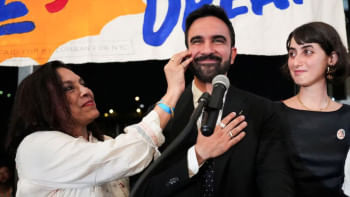A woman is dead. Why are we gossiping about her personal life?

Teacher who married college student found dead. Body of teacher who married college student found, husband detained. Teacher who married college student victim of "murder," not "suicide."
If you come across these headlines while scrolling on social media, alongside photos of a couple sitting close together and smiling into the camera, what would your first impression be? Would you be expecting to read about a "crime of passion?" Would you, perhaps against your better judgement, think, "a woman who married her student! What else did she expect?" Would you look at their obvious age gap and feel a wave of judgement for a woman who seemed to have "preyed" on a young, vulnerable man that she was responsible for teaching?
Perhaps you wouldn't think any of these things at all. But I can almost guarantee that these headlines would give you one impression: A teacher seduced and married one of her students in a complete abuse of her position of responsibility, and something horrible happened as a result.
And in this way, we in the media would be responsible for spreading disinformation – not misinformation, which is the publication of incorrect or misleading information, whereas disinformation is a deliberate deception. Because as we all came to know soon enough and which media outlets who investigated the story found out very early into their reporting, the woman and the man in question – both above the age of 18 and thereby able to give consent to any relationship they enter into – met on Facebook and never had a teacher–student relationship prior to that.
The basic facts of the case are these: On Sunday, a woman was found dead in a house she shared with her husband in Balaripara of Natore. The man left the house in the middle of the night, came home in the early hours of the morning, and the police were called in. While their preliminary findings point towards a case of suicide, they are investigating the matter and the husband has been taken in for questioning.
If we in the media were performing our responsibility to inform our readers of the facts and only the facts, without passing judgement and reflecting our own biases, then perhaps this would be the only information readers would know so far. In an ideal world, the police would also not have speculated to the media on whether the case was one of suicide or something else before proper investigations. And the media would now not be delving into the victim's personal life, playing detective and throwing in masala–filled details into the mix – talking about her husband's reported addiction, her past relationships, her child – to create a sensation around what is essentially a story of trauma, and potentially, of violence.
Some reports have tried to talk about the social shaming and ostracisation the woman faced for marrying a younger man. However, even the well-meaning reports ended up reproducing this shaming to a certain extent by ultimately focusing on the fact that she was an older woman who married a younger man - a teacher who married a student, even if he wasn't her student. If the sexes had been changed, and a man in his early 40s had married a woman in her 20s, would we have thought about it twice, even though the power dynamics are likely to be completely different in such a situation? Regardless of whether you approve or disapprove of such a match, if there is no coercion involved, how does it have any relevance to a report about a person's death under suspicious conditions?
Even in the reports that attempted to paint her in a more sympathetic light, the focus shifted solely to the husband – reportedly a drug addict who borrowed money and put her under a lot of stress. And perhaps that is part of her story (although we need to have a whole different conversation on how harmful stereotypes about drug addiction, viewed only as a crime and not a public health issue, continue to get in the way of national conversations about recovery and support).
But is this really the media's story to tell? What exactly is our responsibility in this situation? To play the role of the police collecting evidence, and discuss what specific injuries there were on the woman, and how her body looked when it was discovered? Are we meant to be the lawyers, delving into her husband's addiction, attempting to find whether it automatically points towards a criminal nature, so we can find if he engineered the whole thing? Or are we simply playing the role of the local gossip, creating clickbait for readers with no regard for the fact that a woman's life has been ended and there are people out there who are mourning her?

This is not the first time media reports have been filled with unnecessary and sensationalist details that distract from the real issue which, more often than not, is violence. Only last month, a woman was murdered by her husband three months into their marriage. This news should have been reported through the frames of gender–based and intimate partner violence. Yet, we mostly saw headlines about a man who murdered his wife because she refused to quit her job. This woman, like many others before her, was a victim of misogynist violence, killed because she failed to conform to gender stereotypes. Under any definition, this should count as femicide, but till now, we have failed to make that word a part of our vocabulary. Instead, our reporting standards came dangerously close to victim-blaming, or at least of opening up avenues to discuss whether the man's reaction was acceptable or not.
In all such cases, the basic fact is that a woman is dead. If she died by suicide, it becomes an opportunity to create conversations around mental health, trauma and social stigma. If she died as a result of intimate partner violence, it becomes an opportunity to talk about about gender-based violence and the structures that perpetuate it, such as a desperately slow criminal justice system, inadequate responses from police or social stigma in reporting violence.
Sensationalising such stories do nothing to create meaningful conversations. And as long as we continue to make light of these cases and report on them as isolated incidents, rather than part of a system that is so often biased against women, we will only be perpetuating a culture that normalises trauma and violence.
Shuprova Tasneem is a member of the editorial team.

 For all latest news, follow The Daily Star's Google News channel.
For all latest news, follow The Daily Star's Google News channel. 





Comments